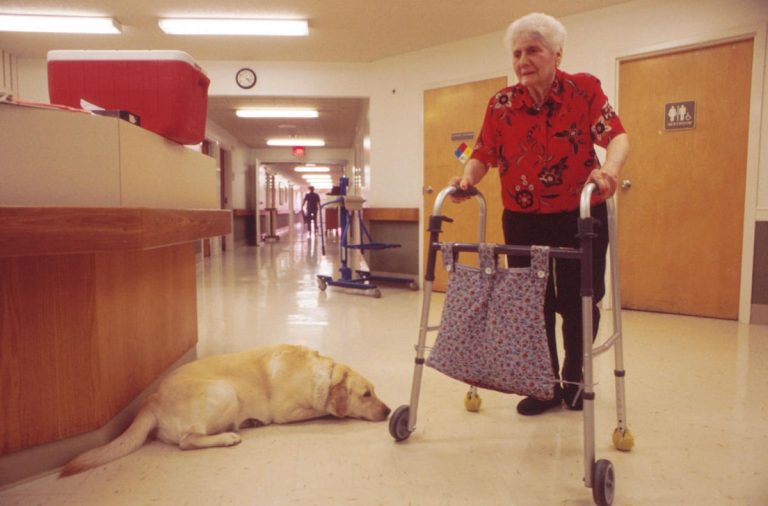In a long-awaited and highly controversial decision, the federal Centers for Medicare and Medicaid Services (CMS) has proposed that nursing homes provide at least three hours of staff time daily for every patient or resident.
Would it meaningfully improve care at nursing facilities? Not by much.
The rule would require facilities to provide enough staff to deliver 33 minutes (.55 hours) of nursing care and 2 hours, 27minutes (2.45 hours) of nursing assistant time each day. A registered nurse would have to be on site 24/7. Separately, the agency asked for comment on a minimum standard of 3.48 hours.
And in a provision that suggests CMS may be considering an entirely different standard, the agency wants to require states to report what share of Medicaid payments each nursing home spends on direct care workers. That and other reporting eventually could be used to require facilities to dedicate a minimum percentage of their revenue to staffing, rather than (or perhaps in addition to) mandating specific hours.
The proposal, which still is subject to public comment, would take effect slowly. Urban facilities would be given three years to hit the minimum target for aides and two years for those 24/7 RNs. Rural facilities would have five years to hire more aides and three years to bring on extra nurses. Facilities in communities with insufficient workers could request exemptions.
Costs And Benefits
CMS estimates the increased staffing would cost about $5.7 billion annually, once fully effective. But it also figures it would lower annual Medicare medical costs by about $300 million since it assumes better staffing at nursing homes would reduce hospital care.
The modest standard hasn’t satisfied patient advocacy groups who believe it falls far short of what is necessary to provide quality care. At the same time, many nursing home operators insist the standard is unattainable.
The American Health Care Assn, which represents mostly for-profit facilities, called the proposed rule “unfathomable.” Leading Age, which represents mostly non-profit facilities, said it was “disappointed” in the proposal and said, “There are simply no people to hire—especially nurses.”
Would It Matter?
What would this new standard mean for residents and patients? There seems to be little clear benefit, in part because the requirement is so modest and in part because the relationship between staffing and quality is ambiguous at best. And there is a high risk of unintended consequences.
The Kaiser Family Foundation estimates that about 85 percent of nursing home residents already live in facilities that meet a standard of three hours of resident care per day. Many states already have tougher requirements. New York State has just begun enforcing a rule that requires nursing homes to provide 3.5 hours. Pennsylvania has increased its minimum standard from 2.7 hours of daily direct care to 2.87 hours. A year from now, it is scheduled to rise to 3.2 hours.
Most researchers conclude that low staffing is associated with poor quality. And higher RN staffing levels are linked to fewer pressure ulcers and other infections; less pain, dehydration, and weight loss; and reductions in hospital emergency room visits and readmissions. A good summary of these findings by University of California, San Francisco professor Charlene Harrington is here.
Staffing And Quality
But associated does not mean that low staffing causes poor quality. Harvard University’s David Grabowski, who authored many of these studies, calls low staffing a “symptom” but “not a root cause” of nursing home problems.
For example, facilities with relatively few staff also may have higher turnover rates, make little use of technology such as mechanical lifts, serve worse food, and provide little resident-centric care. They may also have a more hierarchical management structure and low staff morale.
A few studies have looked at what happened in facilities before and after states imposed minimum staffing rules. One 2015 study by Grabowski and Min Chen found quality may improve, but the results were ambiguous.
A new report by the consulting firm Abt Associates added to the ambiguity by concluding this: “There is no obvious plateau at which quality and safety are maximized or ‘cliff’ below which quality and safety steeply decline.”
That report was funded by CMS but removed from the agency’s website after a Kaiser Health News report disclosed its contents.
Unintended Consequences
Facilities themselves readily acknowledge they are short-staffed but say the causes are beyond their control—the effects of the pandemic, limits on immigration, and, most of all, low payment rates by Medicaid, which funds more than 90 percent of long-stay nursing homes residents.
There are plenty of risks to poorly designed minimum staffing rules. For example, in almost every other industry, firms are rewarded for using technology and other tools to make workers more productive. But if a facility must meet minimum staffing levels, it may lose any incentive to boost productivity, especially since it generally is paid a fixed amount for each patient by Medicare and Medicaid.
Another problem: Unscrupulous nursing home operators could meet minimum staffing levels by relying on low- paid, poorly trained employees who stay for a few months, only to be replaced with other low-quality staff. They could also cut staff and services that are not subject to the new rules.
Is There Enough Money?
Then, there is the issue of supply. The nursing shortage is caused in part by a lack of nursing teachers, a problem that won’t be fixed anytime soon. And nursing homes must compete for workers with hospitals, which generally offer higher pay.
For their part, aides are leaving the profession to take jobs in occupations that not only pay more but are less dangerous.
Finally, there is the matter of those Medicaid payment rates. Yes, they are less than half of what Medicare pays. And many nursing facilities, especially not-for-profits, are in deep financial trouble. But many other facilities are highly profitable. That suggests there is money in the system to hire more staff. But it is not evenly distributed and many facilities, especially mission-based non-profits, could be forced to close if their labor costs rise more than they already have.
Minimum staffing may be a rough proxy for quality and minimum requirements may discourage bad management from endangering residents and patients by skimping on nurses and aides. But they come with costs and the CMS version, at least, isn’t likely to solve the problems faced by nursing facilities and their residents.
Read the full article here









